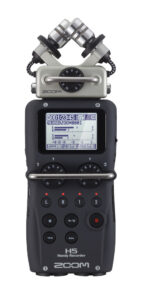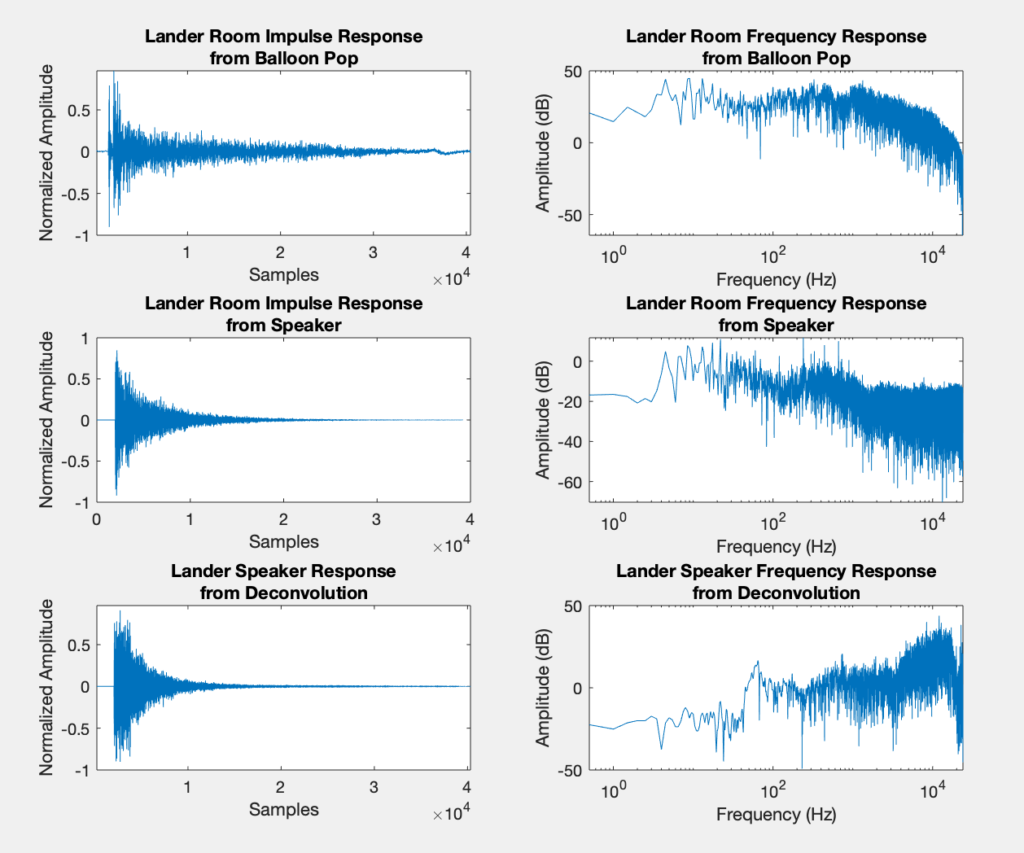Introduction
Our project for this semester focused on comparing real usage scenarios of professional speakers within different lecture halls on the University of Rochester River Campus. This focus originally came from looking at the Genelec speakers in CSB 616 and wondering as a group what these expensive, professional speakers would sound like in a livelier, more spacious environment. Would a student in a large lecture hall, like Lander Auditorium, benefit from hearing a professor speaker out of a Genelec 8341A rather than the speakers already found within the lecture hall? Conversely, would speakers less expensive than Genelec sound just the same as in CSB 616? In trying to solve this, we decided to calculate the room and speaker response from 3 speakers and lecture halls and with this data simulate what each pairing of speakers and rooms would sound like to a student in the back of each hall.

Recording Setup and Why We Are Collecting This Data
We decided to look at 3 different classrooms and lecture halls, each of a differing size and/or configuration. This allowed us to not only look at different speaker usage scenarios, but also different lectures and different needs as the student listener. We chose CSB 616 as our small classroom containing a surround system of Genelec 8341as, B&L 109 as our medium classroom, and Lander Auditorium as our large classroom, with both rooms containing JBL PRX812s. Impulse responses and frequency sweeps were recorded in each classroom using a Zoom H5 Recorder. The impulse response was taken by recording a short auditory excitation, such as a balloon pop or a hand clap, while the frequency response was measured by recording a predetermined logarithmic sine sweep played through the speakers in the room.

We chose to take an impulse and a frequency sweep of the room because we thought it was the best method to indirectly get a good speaker response from each speaker. Ideally, we would’ve wanted to take those speakers off the walls and test them in an anechoic chamber by themselves. Sadly, these speakers are mounted onto the walls and we can’t take them off so we used some system based reasoning that we learned in Signals. In trying to determine the response of the speaker, one can think of the sound that we hear from a speaker in a room like a LTI system. The original wave file (denoted as X(z) below) is altered by two responses – the response of the speaker its playing through (denoted as S(z)) and the room where the sound is playing (denoted as R(z)). This total response, written as H(z) is simply the convolution of R(z) and S(z) in the time domain.

To get the speaker response on its own, one can either convolve it with the inverse of R(z) in the time domain or divide by r[n] in the frequency domain. In other words, the equation for finding the speaker response is S(z) = H(z) ∗ R-1(z) in the time domain, or s[n] = h[n]/r[n] in the frequency domain. Because MATLAB allows us to perform convolutions rather easily, the extraction of each speaker response was done almost exclusively in the time domain.
Data Collection
The first step in making this calculation work was to alter the frequency sweep recording we captured in a way that would output the response S(z). MATLAB has an open source function called extractIR.m developed by Oygo Sound that, in conjunction with synthSweep.m, allows for this conversion to be made. Once that was completed, each classroom went through the same process explained in the preceding paragraph. Each of the three classrooms is represented below by its room response, room/speaker response, and speaker response in both the time and frequency domain.

Being the smallest room, it is understandable to see such a small, weak tail to CSB 616’s impulse response. The room is quite small with a full carpet and acoustic paneling. Looking at the room frequency response of the speaker, it is interesting to note the overall flat response all together, especially within the 1k-20k region.

Moving onto the mid size room, it is apparent that our reverberation time is increasing as shown in the bigger and extended tail of the room impulse. Across both the Room and Speaker frequency responses, there seems to be a rather sudden drop in amplitude 10k and higher, suggesting that high harmonic content when played in this room will be lost in comparison to lower harmonic content.

Finally, Lander Auditorium has quite a long reverberation time (just over 1 second!) and seems to have a rather nice room frequency response. However, the speaker response created from deconvolution doesn’t really seem plausible, especially in the higher harmonic content.
In general, when looking at all of the time domain speaker responses, it is clear that we are not getting an ideal response. These speaker responses should look close to delta functions but instead they all have a bit of tapering over time. This unfortunately leads to exceeding error when it comes to the simulation of room/speaker combinations. Below, you can find the rough simulations of what it would sound like to have a lecturer speak through different speakers within different rooms.
Conclusion
Although there are undoubtedly some problems with the output audio, qualitatively there are features of the speakers that can be tracked like slight high pass and low pass filtering that are altered when put into larger and smaller spaces.
There were a couple unavoidable issues that we ran into while taking measurements for this project. Due to the obstacles of this semester, we didn’t have the opportunity to take our speaker impulses from within an anechoic chamber, which would be the ideal solution to obtaining the speaker response. As a result we had to deal with deconvolution, one of the least understood and most difficult aspects of acoustical analysis. This lead to some of the less than ideal results for the speaker analysis, specifically some of the frequency and impulse responses that we got. In addition, there’s the inevitable error that comes from real world measurements, in this case, ambient noise, specifically the air conditioning of the rooms, as well as differences in microphone distance and impulse gain.
Overall, this was an exciting project and experiment to work on and it nonetheless taught us about the importance of considering inherent challenges to making a procedure that yields ideal results in addition to spatial acoustics in general.
Citation
- The Basics of Convolution in Audio Production.” IZotope, 20 Oct. 2020, www.izotope.com/en/learn/the-basics-of-convolution-in-audio-production.html.
- “Convolution.” From Wolfram MathWorld, mathworld.wolfram.com/Convolution.html.
- Modeling Reverberation Time, hyperphysics.phy-astr.gsu.edu/hbase/Acoustic/revmod.html.
- “Acoustics and Vibration Animations.” Sound Fields Radiated by Simple Acoustic Sources, www.acs.psu.edu/drussell/Demos/rad2/mdq.html.
- Oygo Sound LLC. “Swept-Sine Analysis.” Swept-Sine Analysis – File Exchange – MATLAB Central, 2 Dec. 2010, www.mathworks.com/matlabcentral/fileexchange/29187-swept-sine-analysis.